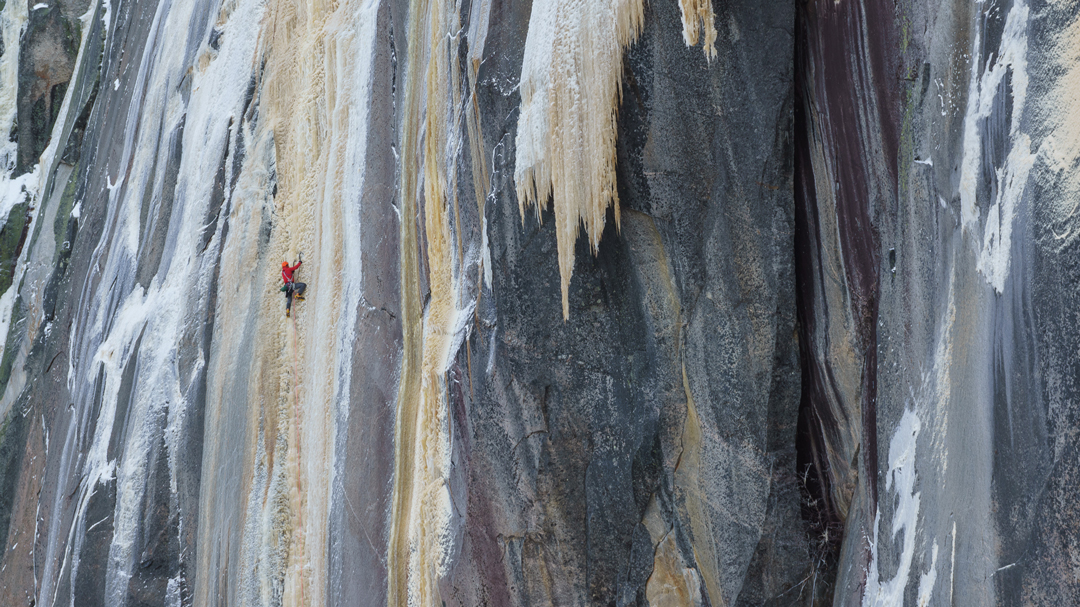Nipissis River Area, Le Mur du 51, New Routes
Canada, Québec

The Nipissis area is a premiere ice climbing venue in Québec that was discovered by Patrice Beaudet during a ski traverse in 1994. Over numerous trips, he gave the area his undivided attention, climbing many classics lines, including Le Filon (145m, III WI5) and Le Chercheur D'or (160m, III WI5+). After creating a small PDF guidebook to the area, Patrice named some of the still-unclimbed flows, tempting other climbers to explore the cliffs. Though local climbers from Sept-Îles occasionally climbed at Nipissis, few others explored the area.
From February 18–26, 2016, Jean-Philippe Belanger and Charles Roberge (both from Québec), Jasmin Fauteux (Alberta), Pete Takeda (Colorado), and I camped below the headwall of Le Mur du 51 on the Nipissis River. We approached by a Tshiuetin Rail train, which we rode north from the city of Sept-Îles. Tickets can be bought for specific drop-off locations, and we were fortunate to disembark very close to the headwall at mile-marker 51. We were excited to see plenty of ice, despite it being a substandard year for the area.
 Due to the dense boreal forest, the only easy camping and traveling we found was on the frozen Nipissis River. We established a base camp with modern luxuries, including a prospector tent with wood stove—crucial for drying ropes and equipment during the -35°C nights.
Due to the dense boreal forest, the only easy camping and traveling we found was on the frozen Nipissis River. We established a base camp with modern luxuries, including a prospector tent with wood stove—crucial for drying ropes and equipment during the -35°C nights.
The best climbing at Le Mur du 51 is characterized by thin ice flows over granite slabs, which kept forming throughout our stay. The mineral-rich water produces beautiful golden ice climbs, almost dark brown in spots. These dissolved minerals also lower the freezing point of the water, which means the climbs keep rejuvenating even when the thermometer drops below -20°C. Several of the harder classic lines sport unrelenting steep pillars for their entire length.
Due to our timing, we were fortunate to climb several new lines, some of which were entirely unformed when we arrived. The most aesthetic of these lines was Âme du Nord (125m, IV WI5 R M6), which translates to “Northern Soul.” A well-protected M6 corner gains a thin flow out of a shallow chimney/crack through the granite slab. Stepping out from this belay, the crux second pitch climbs the thinly iced chimney, poorly protected by short screws and rock gear through a section of 1-2cm ice.
In addition to Âme du Nord, we climbed five other new lines and variations. La Fourchette Sternale Droite (160m, WI5) is an aesthetic, narrow line with a body-wide section of steep ice on its first pitch. In 1999, Patrice had attempted the first 30m in -30°C conditions, before retreating in fear of cold-induced injuries. With the first pillar of Le Chercheur d’Or unformed, we attempted to free a mixed start (Chilkoot Trail, 15m, M7 A0 WI6) to connect to the remaining 120m of steep ice. Despite some solid efforts, we were unable to free this pitch or continue up the remaining ice. Ectoplasme (110m, WI5+), La Variation du Neerlandais (100m+, WI4), and Petite Pepite (120m, WI5) each climb independent ice lines along the wall.
When we first arrived, we’d been worried we would run out of things to climb. By our eighth day, we wished we had another week to climb. None of the currently established climbing at Le Mur du 51 is cutting-edge, and perhaps the real value in climbing here doesn't lie in the next rad Instagram post or coming up with a new ice grade. The remoteness, good people, and excellent climbing offer something I haven't found anywhere else in my winter travels. Despite the excellent ice climbing in the Canadian Rockies (where Jasmin and I frequently climb), neither of us can wait to return to Québec this February. Nipissis and northern Québec hold many unclimbed gems waiting to be explored.
– Maarten van Haeren, Canada








